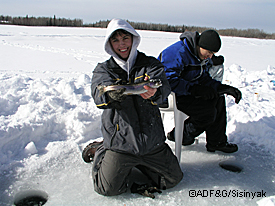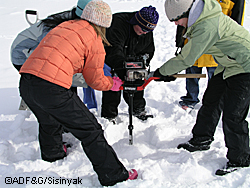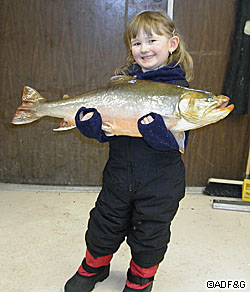Alaska Fish & Wildlife News
February 2005
Outsmarting Murphy’s Law: Ice Fishing in Alaska

“I’m going to try a Cheeto.”
This was the remark made by an especially bored sixth grader on one of our Alaska Department of Fish and Game sponsored ice fishing outings. The fishing had been slow and the kids were all sitting around their ice fishing holes eating lunch. Richard Barnes, Fairbanks-based fisheries technician, replied, “You can’t catch a fish on a Cheeto.”
“Why not? Have you ever tried it?”
“Well, no.” Richard responded, “But...”
Richard never got to finish his sentence. The Cheeto-baited hook had barely cleared the bottom of the ice when the young angler was hauling it back out with a feisty, albeit small, coho salmon clamped onto the hook.
Richard and I simply looked at each other knowingly and shook our heads. We had been here before. We are constantly learning things like “Cheetos DO make good bait.” Useful, perplexing, and troublesome things like… a power auger, which has been performing well all winter, will choose not to start on the trip 75 miles away from home with 17 boy scouts depending on you for a day of ice fishing; an ice fishing ladle, when kicked by a six year old, is guaranteed to gee and haw across the frozen landscape with a mind of its own until it finally splunks down a hole with a resounding slurp and disappears forever; you are guaranteed to drive your auger into the silt only on those occasions in which you do not have extra blades; no matter how many times you stress wearing proper clothing, someone in your group will show up for the day’s ice fishing in tennies and spandex; and Murphy’s Law is always in effect…if anything can go wrong, it will.
Given these and other dilemmas that plague the ice fishers of Interior Alaska, the following are some tips and tricks, in no particular order, to make your ice fishing outings more enjoyable and hopefully more successful.
• Do all of your prep work before leaving the warmth of your home or cabin. Simple things like tying on a lure are considerably more difficult out on the ice at 20 below. Untangle the line on those rods from the last trip. Rig your rods right up to the terminal tackle. Check your tackle and make sure you have all the necessary jigs, bait, hooks, ladles, etc. Start the power auger to make sure it is running properly, even if it was working fine last time. Check the blades. Are they sharp? If not, replace them and always take extra blades. Top the auger off with properly mixed fuel. Take a hand auger (and a 16 year-old kid) as backup in the event the power auger fails. Make sure everyone in your party is dressed for the weather. Your ice fishing outing will last only as long as the most inappropriate dressed individual will allow. Don’t forget, many lakes will have overflow water beneath the snow pack, on top of the ice, making waterproof boots a must. If you are not severely limited by space, take extra clothing and blankets in case someone gets wet or cold.
• Alaska statewide regulations allow you to ice fish using two rods, or one rod and one tip-up, provided only one hook or artificial lure is used on each line, and as long as both set-ups are closely attended. When fishing in a party, have each angler fish at two different depths. For example, if you have four people, one can fish at 10 feet and 15 feet, the next at 20 and 25 feet, the next at 30 and 35 feet, and so on. You will be able to find the fish faster using this cooperative strategy. When one angler catches a fish, all others can begin fishing the same depth.

• One of the really fun things about ice fishing is being able to see your quarry. Shovel a wide area down to bare ice around your ice fishing hole. Cover your head with a heavy quilt and look down the hole. Light penetrates the ice that has been cleared of snow, and since you are under the blanket in the dark, you are able to see into the water and watch the fish as they investigate your bait. For added fun, start saving your egg shells; crush them and dump them down your ice fishing hole. The egg shells make a light background on the bottom of the lake; you’ll see the dark-bodied fish even better!
• Different ice fishing lures give you different action when you jig (slowly pull the rod up and then drop it down to its original position). Spoons tend to give a flutter motion, flashing as the light bounces off their shiny surface. Airplane jigs spiral up and spiral back down in a circular motion, attracting fish with their acrobatics. Jigging Rapalas mimic the movements of a small feeder fish. It is hard to tell which lures or action the fish are going to respond to and when. The trick is to be patient and change lures and attractors when the one you are using isn’t producing results.
• Most fish use the senses of sight, sound (vibration), & smell to locate food. Attracting fish to your hook by targeting two or more of these senses should increase your catch. For sight, use a colored hook or jig and a smooth jigging motion. For sound, try using a sound chamber (a small plastic tube with a few bbs in it that knock together when the line is jigged. When initially dropping your lure/bait in the water, do so with a resounding “plop.” For smell, use oily bait that gives off good scent such as squid, shrimp (not cooked), salmon eggs, or Power Bait.
• Use all resources at your disposal when thinking about fishing a lake you are unfamiliar with. ADF&G has bottom contour maps of many area lakes available. Talk with local tackle shop owners and find out where and what is hot. Look for evidence of good fishing holes: an ice hole with a little blood and fish innards lying near is a good sign of success at that spot. Where are most of the ice houses positioned on the lake? A beaver house on the bank is a good indicator of a steep drop off. Look for “edge”, that is, try fishing where two habitats come together. For example, inlet and outlet streams, off jutting points of land, where the aquatic vegetation ends, and where a nice shelf suddenly drops off to deeper water.
• Have you ever accidentally kicked your ice ladle down your fishing hole? Has junior ever dropped your lucky pole into the murky depths of your favorite lake? Try tying a small, empty, capped plastic beverage bottle to your ladle and the kids’ ice rods. When that well placed kick sends those hole-seeking items across the ice and down into the water, the home-made bobbers will keep them afloat at the top of the hole for easy retrieval.
• Keep the blades on your auger sharp. All it takes to dull your auger blades is to grind them into the lake bottom just once. If the auger isn’t walking its way through the ice with relative ease, your blades are most likely dull. When fishing an unfamiliar lake, drill your first hole far off shore to avoid grinding the auger blades into the silty bottom. With each successive hole you can work your way toward shore. While drilling your ice hole, pull the auger up several times during the drilling to clear the hole of ice shavings. This helps prevent getting the auger stuck. Just before you break through the lower edge of the ice, remove the auger from the hole and shovel the ice shavings and snow, from around the ice hole. Return to the auger and punch the hole through the bottom of the ice. By clearing the ice shavings and snow from around the hole before it is soaked with the lake water, you have a flat, comfortable area from which to fish.

• Except in areas of upwelling from springs and areas around inlet streams, the temperature throughout a given lake in the winter is relatively homogeneous. Fish that may only be found in certain areas or depths of a lake, due to a favored water temperature in the summer, do not have that limitation in the winter. Your lucrative summer fishing hole may not be as productive in the winter since the fish are not limited to holding in deep, cool holes. The whole lake is now a deep, cool hole. Fish will still have their preference for hang-outs based on other factors such as light penetration, availability of food, and adequate oxygen concentration. Usually, coho salmon are caught just below the ice, rainbow trout tend to run a little deeper, and Arctic char are typically closer to the bottom of the lake.
• Northern pike tend to feed above them. Jig within the upper half of the water column. For example, if you are fishing in 12 feet of water you should jig your lure and bait within the upper six feet. Northern pike seem to be attracted to splashing, so use your ladle often to clean out your ice fishing hole. Exaggerate the splashing. The pike have been under the ice all winter and the sound of your ladle clearing the hole may be the first splashing they have heard since ice-over. They will come to investigate.
• When taking kids ice fishing, have alternative ideas for something to do in case the fish are not biting or Murphy sabotages your trip in some other creative manner. Take snowshoes and or cross country skis. Have them race each other. Look for and identify tracks in the snow. Slide on the ice. Go on a little hike. Play Simon Says…anything to keep them moving. If you do not have alternative activities, all kids will remember from their fishless ice fishing outing is being bored out of their melons. If this happens, the mere mention of a family ice fishing trip will send them running to their rooms to sit in a corner.
• If you use a portable heat source to keep your ice house warm, be sure to maintain proper ventilation. Carbon monoxide can overcome conscious and sleeping individuals. Step outside the house occasionally, crack the door, and/or cut a vent in the roof and along the floor line.
Armed with these few tips, you should be able to avoid some of the maladies with which Murphy may try to plague your ice fishing venture. As always, good fishing. <”}}}}><
http://www.adfg.alaska.gov/static-sf/Region2/pdfpubs/icefish.pdf
http://www.adfg.alaska.gov/static-sf/Region3/PDFs/icefishing.pdf
Subscribe to be notified about new issues
Receive a monthly notice about new issues and articles.
